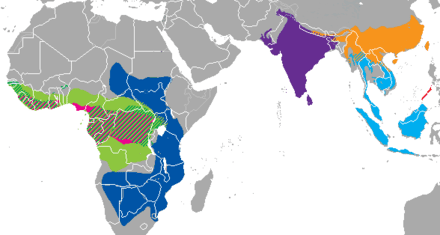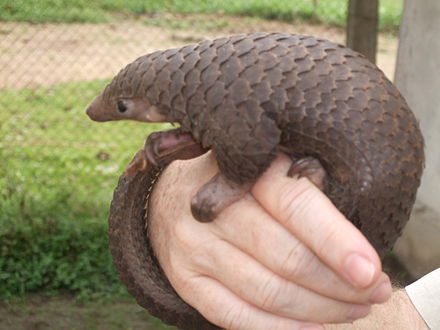 Taken from pangolins, it has been found that the virus cause of COVID-19 is a “curse of the pangolin”.
Taken from pangolins, it has been found that the virus cause of COVID-19 is a “curse of the pangolin”.
The mammal Pangolin is hunted as game meat for both medicinal purposes and food consumption.
In addition, seven out of eight species of pangolins are threatened with extinction within the next generation. They have been a valuable commodity for millennia: already in ancient times, the Chinese people hunted them for their delicious meat, while in Africa they are sold at the market, and Vietnam considered as expensive local delicacies. The most sought after dish is that of a base of young pangolins, served in a soup.
Another surge has taken place in recent years, with the fashion of keeping a pangolin at home as a pet: from 2006 to today, over a million of them have been captured and killed, or claimed alive as pets.
The “curse of the pangolin” does not end here, above all, its scales are attributed, by Chinese and Vietnamese culture, to thaumaturgical and magical powers. At least 15 different traditional Chinese medicines require the use of pangolin flakes, which are boiled, roasted, smoked or breaded to fight any possible and imaginable syndrome, from the hysterical cry of children to demonic possessions.
Moreover, 99% match of Nucleic acid sequences of viruses taken from pangolins have been found to be those of the the virus that causes COVID-19, SARS coronavirus 2 (SARS-CoV-2), and is responsible for the 2019-20 coronavirus outbreak.
The working theory of researchers in Guangzhou, China is that SARS-CoV-2 originated in bats and, prior to infecting humans, was circulating among pangolins.
The illicit Chinese trade of pangolins for use in traditional Chinese medicine is suggested to be a vector for human transmission.
Who are the Pangolins?
Pangolins are the most trafficked mammals in the world.
They are the only living mammals representing the order of Pholidota, family of Manidae which is comprises of three Manis genera:
1. Manis-Manis: four species living in Asia
- Malayan pangolin- Javanica (del Borneo),
- Chinese pangolin- Pentadactyla,
- Indian pangolin- Crassicaudata,
- Philippine pangolin- Culionesis
2. Manis-Phataginus: two species living in Africa
- Tree pangolin- Tricuspis (tricuspide o arborea pangolin),
- Long-tailed pangolin-Tetradactyla
3. Manis-Smutsia: two species also living in Africa
- Giant pangolin- Gigantea,
- Ground pangolin- Temminckii
All the living species have been assigned to the genus Manis.
They have been added to the Zoological Society of London’s list of evolutionarily distinct and endangered mammals, in 2010, and in January 2020 the IUCN considered all eight species of pangolin on its Red List of Threatened Species as threatened.
Also Taiwan (China), which is one of the few conservation grounds for pangolins in the world, has enacted the 1989 Wildlife Conservation Act, and registered as the country with the highest population density of pangolins in the world.
To further make improvement of the Wildlife Conservation Act, the third Saturday in February is promoted as World Pangolin Day by the conservation NPO Annamiticus.
To this extend, though, pangolins are protected by an International ban on their trade, their populations have suffered from illegal trafficking due to beliefs in East Asisa that their ground-up scales can stimulate lactation or cure cancer or asthma.
Instead Pangolins are still hunted and eaten in many parts of Africa, taken as one of the most popular types of bushmeat, and by other local healers to be a source of traditional medicine.
Threatened by poaching, for their meat and scales, to be used in Chinese traditional medicine, Pangolins are in high demand, in southern China and Vietnam, because of their scales are believed to have medicinal properties.
And their meat considered as delicacy: nearly a 100,000 are estimated to be trafficked every year to China and Vietnam, amounting to over one million over the past decade. This makes it the most trafficked animal in the world.

The physical structure of Pangolins ranges from 30 to 100 cm (1 to 3 ft.) in heigh, the coat is made of large hardened overlapping plate-like protective keratin scales, covering their skin; they are the only known mammals with this feature. They have very poor vision, so they rely heavily on smell and hearing, and also lack of teeth.
The structure of their tongue and stomach is key to aiding pangolins in obtaining and digesting insects, in fact their saliva is sticky, causing ants and termites to stick to their long tongues when they are hunting through insect tunnels.
Thus, pangolins are insectivorous, they can consume 140 to 200 g (4.9 to 7.1 oz) of insects per day, and for this reason are an important regulator of termite populations in their natural habitats.
Within the years Pangolins have significantly decreased immune responses due to a genetic dysfunction, making them extremely fragile.
They are susceptible to diseases such as pneumonia and the development of ulcers in captivity, complications which can lead to an early death.
In addition, pangolins rescued from illegal trade often have a higher chance of being infected with parasites such as intestinal worms.
In the past decade, numerous seizures of illegally trafficked pangolin and pangolin meat have taken place in Asia. In particular:
- in April 2013, 10,000 kg (11 short tons) of pangolin meat were seized from a Chinese vessel that ran aground in the Philippines.
- in August 2016, an Indonesian man was arrested after police raided his home and found over 650 pangolins in freezers on his property.
The same threat is reported in many countries in Africa, especially Nigeria.
